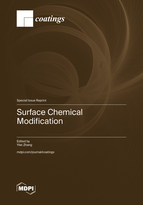Surface Chemical Modification
A special issue of Coatings (ISSN 2079-6412). This special issue belongs to the section "Surface Characterization, Deposition and Modification".
Deadline for manuscript submissions: closed (28 February 2021) | Viewed by 78522
Special Issue Editor
Interests: intelligent design and manufacturing; spiking neural network; bioprinting; neuroengineering
Special Issues, Collections and Topics in MDPI journals
Special Issue Information
Dear Colleagues,
We would like to invite you to submit your work to this Special Issue on "Surface Chemical Modification". Surface chemical modification is the modification of the surface of a material by introducing different chemical properties different from the ones originally found on the surface. With the development of engineering and science in the micro/nano scale, the precise control of surface chemical properties is becoming increasingly critical in both fundamental scientific researches and applied engineering applications, such as biology, energy, environment, etc. Vast scientific and technological progress has been achieved on this topic by universities and research institutes all around the world. This progress has been supported by the industrial development of novel characterization and deposition tools. The aim of this Special Issue is to present the latest experimental and theoretical developments in the field, through a combination of original research papers and review articles from leading groups around the world.
Prof. Dr. Yilei Zhang
Guest Editor
Manuscript Submission Information
Manuscripts should be submitted online at www.mdpi.com by registering and logging in to this website. Once you are registered, click here to go to the submission form. Manuscripts can be submitted until the deadline. All submissions that pass pre-check are peer-reviewed. Accepted papers will be published continuously in the journal (as soon as accepted) and will be listed together on the special issue website. Research articles, review articles as well as short communications are invited. For planned papers, a title and short abstract (about 100 words) can be sent to the Editorial Office for announcement on this website.
Submitted manuscripts should not have been published previously, nor be under consideration for publication elsewhere (except conference proceedings papers). All manuscripts are thoroughly refereed through a single-blind peer-review process. A guide for authors and other relevant information for submission of manuscripts is available on the Instructions for Authors page. Coatings is an international peer-reviewed open access monthly journal published by MDPI.
Please visit the Instructions for Authors page before submitting a manuscript. The Article Processing Charge (APC) for publication in this open access journal is 2600 CHF (Swiss Francs). Submitted papers should be well formatted and use good English. Authors may use MDPI's English editing service prior to publication or during author revisions.
Keywords
-
Two-dimensional nanomaterials
-
Nanoparticles
-
Microfluidic devices
-
Reinforcements
-
Biology
-
Energy
-
Environment
-
Natural materials






